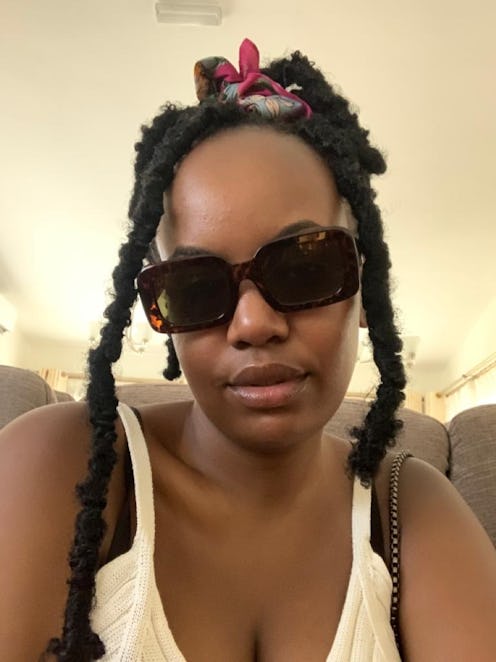Beauty
Here's What Happened When I Tried Butterfly Locs
Don’t make the one mistake I did.

Like many Black women, I grew up wearing protective styles to give my natural or processed hair a break. When I was young, I was devoted to braids — cornrows and box braids in particular. As an adult, I’m now experimenting with other hairstyles to give my strands (and arms) a much-needed time out. Low-tension styles are of top priority (my sensitive scalp won’t accept anything else), which is what recently led me to butterfly locs.
According to Black Beauty Bombshells, butterfly locs are “are a variant of faux locs achieved using the crotchet method where wavy hair is looped into a braid using a crotchet needle and then loosely wrapped to give it a distressed/unraveled look.” Prepping your hair before getting the style looks different than prep for other protective styles. “Since your hair is being completely covered by the butterfly locs, you would prep your hair differently than you would with regular braids,” says celebrity braider and Darling Hair ambassador Xia Charles. “You should fully moisturize your hair. The spring twist hair or the loc being wrapped around your braid can be drying, so it’s necessary that you moisturize your hair the best way you see fit.”
I wanted to try butterfly locs because the promise of a minimal-tension protective style was alluring, as was the opportunity to channel Ciara, Little Mix’s Leigh-Anne Pinnock, and other celebs who’ve worn the look. My shoulder-length, jumbo butterfly locs took almost two hours to install at the salon (a significant difference compared to the several hours it usually takes to get braids installed). It was relatively painless too, which my scalp appreciated.
I loved the way my butterfly locs looked. The chunkiness took some getting used to — the two front strands kept swinging in my face, which was annoying in the beginning — but once I figured out how to hold it back (I found a small scarf worked best), I was happy with my new look.
After barely a week of wearing my locs, my scalp started feeling extremely itchy and tender. I later found out that the irritation may have been caused by alkaline lye, a chemical coating sometimes sprayed on synthetic strands to make extensions wear and heat-resistant. Many are allergic to the formula, which can cause small bumps on the scalp, extreme itchiness, and tenderness. Soaking the extensions in something acidic prior to installation, like apple cider vinegar, can help strip the hair of alkaline lye.
Not knowing this, I tried everything to help the irritation: hot towels, leave-in conditioner, sprays, oils, prayer. Nothing provided long-term relief. Another week later, I couldn’t take it anymore. I took out my locs in a moment of frustration. Pro tip: don’t take out a protective style you’ve never worn before while angry, unless you’re willing to risk accidents. Prior to grabbing my scissors, I neglected to research how to remove the style, and figured I would take them out the same way I do braids — cutting them from the bottom and unraveling the strands.
Spolier alert: That didn’t work. For some reason I struggled to unravel the loops and twists of hair creating my locs. It took way too long (around 30 mins) to take out one, and impatience got the best of me. Thinking it would save time and effort, I decided to cut the strands wrapped around the root of my hair creating the foundation of the loc.
That was the wrong approach. It was extremely difficult to figure out how much faux hair was wrapped around the root, and I ended up cutting a decent chunk of my hair.
“Be careful cutting the locs because it’s very easy to snip your hair,” Charles advises. “Once the end of the loc is cut, unraveling is so much easier.” Plus, your own strands will remain in tact. Though it didn’t work for me at first, I just needed to be a little more patience and use a mirror to help me unravel the loc. The latter is a major game changer. Depending on your style and how long you’ve worn it, you can sometimes find your braid in the loc and pull it out. Then, you can cut the loc off and pull the extension out much more easily. That’s how I removed the rest of my butterfly locs.
Charles also suggests “going in with a leave-in conditioner or a water-based detangler to soften buildup so that you’re not losing much or any hair in the detangling process.”
If you want to try butterfly locs, I highly encourage you to do so. Just make sure your hair is hydrated prior to installation and you know how to properly take them out, and butterfly locs may be your new favorite protective hairstyle.
This article was originally published on